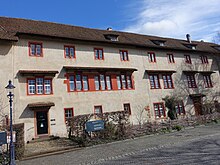Small Klingental Museum
The Kleines Klingental Museum in Basel (also known as the Klingental Museum for short ) is located in the “Kleines Klingental” building of the former Klingental nunnery from 1274 and was founded in 1938/39 as the “City and Minster Museum ”. The museum houses the collection of original sculptures from Basel Minster , which were replaced by copies during restoration work. The museum also houses a model of the city of Basel as it looked in the 17th century and a model of the Klingental monastery in the 16th century. The museum is managed by the Basel-Stadt cantonal preservation authorities.
museum
In 1938/39 the “City and Minster Museum ” was established in the “Kleiner Klingental” with collections from the Basel Historical Museum and the Protestant Reformed Church of Basel-Stadt. The Basel-Stadt cantonal preservation of monuments has its headquarters in the same building. In 1996, the museum was closed as a state-run operation due to cost-cutting measures. However, it was retained in its previous premises as the “Museum Kleines Klingental”, which is supported by a foundation, and was reopened in 1997.
The museum has original medieval sculptures from Basel Cathedral ( Romanesque and Gothic sandstone - sculptures ) and the story shows the monastery. On the first floor there is the city model of the medieval Greater and Little Basel in the 17th century on a scale of 1: 400, made 1952–1959 by Alfred Peter. The basis of his presentation was the bird's eye view of the city of Basel by Matthäus Merian the Elder from 1615. There is also a model of the monastery properties from 1510 with the church and the separate commercial buildings such as mills and grain stores. Noteworthy is the model of the cloister on display with a reconstruction of the Kleinbasler dance of death based on the original condition from 1460/80.
Monastery and monastery church
After the Augustinian order of Rouffach moved to the Klingental monastery newly founded by Walther von Klingen in Wehr in 1253, the latter was only able to enjoy their new monastery for a few years. The forcible takeover of the rule of Wehr by the later King Rudolf von Habsburg was probably the reason that the canons had to give up their seat again in 1272 in order to move to Kleinbasel .
In 1274, twelve Dominicans who had come to Basel from Alsace via the Black Forest settled in Kleinbasel . The name of the monastery comes from the patron of the nunnery, the minstrel and knight Walther von Klingen .
The monastery buildings were built in a separate monastery district on the banks of the Rhine below the Middle Rhine Bridge , for which the city wall was expanded. The original bedroom and living quarters of the nuns were in the founding building of 1274, the “Little Klingental”. In 1293 the monastery church, the "Grosse Klingental", was consecrated. Beyond the church, the nuns had large residential buildings built so that from 1305 the “Little Klingental” could be left to the lay people of the monastery. The Klingental monastery, in which 52 nuns lived in its prime, was the richest and most distinguished monastery in Basel. It was abolished in the course of the Reformation in 1557 and then used for storage and commercial purposes and as accommodation for the troops. Reformed services were held in the church, which was given intermediate floors, until 1779. From 1804, the Grosse Klingental was mainly used as a barracks and parade ground (stables in the church), some areas were also used for civil purposes (cattle pastures, gymnastics area, workplaces for builders). In 1860 the residential buildings beyond the church had to give way to the new barracks. Since then, only the “Little Klingental” with its preserved historical interiors and the exterior of the church choir have been a reminder of the existence of the monastery. Since the military left in 1966, the main wing of the barracks has been used as a school, and artists' studios have been set up in the church. The Kaserne Basel cultural center, which opened in 1980, is located in the former stables and riding hall of the barracks .
literature
- Ruedi Gröflin: Küentzi. Novel. Basel 2016.
- Dorothea Schwinn-Schürmann: Klingental Abbey in Basel. Basel 2002, ISBN 3-9522444-0-6 .
- Bernard Jaggi, Dorothea Schwinn: The Klingental monastery in Basel. (Swiss Art Guide, No. 473). Ed. Society for Swiss Art History GSK. Bern 1990, ISBN 978-3-85782-473-9 .
Web links
Individual evidence
- ↑ Hans Georg Wehrens: The dance of death in the Alemannic language area. "I have to do it - and don't know what" . Schnell & Steiner, Regensburg 2012, p. 72ff., ISBN 978-3-7954-2563-0 .
Coordinates: 47 ° 34 ' N , 7 ° 35' E

